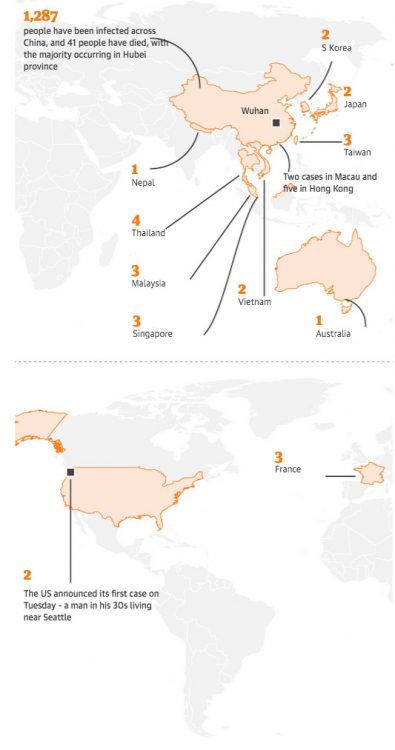— Saad Omer, Director, Yale Institute for Global Health, and Prof. of Internal Medicine and Epidemiology, Yale School of Medicine and Yale School of Public Health,
January 24, 2020
“I consider myself a veteran in battles such as bird flu, SARS and other outbreaks. But with this Wuhan pneumonia, I feel extremely powerless.”
— Guan Yi, M. D., SARS expert, Hong Kong, China, January 24, 2020
“The lesson we’ve learned is coronavirus infections are serious and one of the newest and biggest global health threats,” with the potential for a pandemic.
— Peter Hotez, Ph.D., Vaccine Researcher, Baylor College of Medicine, Houston, Texas, January 23, 2020
Saturday Morning Update Albuquerque: January 25, 2020 Wuhan, China – “Faced with the grave situation of an accelerating spread of the new coronavirus, it is necessary to strengthen the centralized and unified leadership of the Party Central Committee,” China’s President Xi Jinping warned on Saturday as the Wuhan coronavirus has now spread to at least 30 regions and provinces in China. China has also started building a second Wuhan hospital as the medical community there is overwhelmed by the rapidly increasing cases. The United States is evacuating all American citizens in Wuhan by chartered flights.
The map below shows that Wuhan has now jumped to 1,287 confirmed cases and 41 deaths, with other confirmed cases spreading beyond Wuhan that include three in France, one in Australia and two in the United States. The European Centre for Disease Prevention and Control expects more European cases.

Locked down since Wednesday, residents in Wuhan where the new coronavirus first erupted, people lined up at hospitals with coughs and fevers are speaking angrily that there aren’t enough doctors or hospital beds to handle the crisis. “You shouldn’t tell us we can’t leave Wuhan, and then give us second-rate medical care. That’s unfair,” said Yang Lin, 28, to The New York Times.
A video from a Chinese messaging app WeChat was released yesterday in which Storyful says the footage was taken yesterday on January 23, 2020, by a woman claiming to be a nurse at the Wuhan Red Cross Hospital swamped by people worried they could have the new, deadly coronavirus. Long lines could be seen outside the hospital and filling the lobby, with blood infusion rooms and observation wards all overcrowded. The video was cross-posted to Weibo, a website similar to Twitter. But then the video was removed, leaving a Twitter message. The social media-monitoring agency Storyful was unable to independently confirm if the individuals covered by sheets in the video are dead. But before the video was taken down, this translation was posted of the alleged nurse speaking about scenes in the video:
“Three bodies have been lying here the whole morning. Some people are already dead. Until now, nobody’s come to take care of them. Doctors and nurses are all here working in these conditions… I’ve just looked for the person in charge; there’s no leadership and even if there were, they wouldn’t be able to solve this.”


Data from the National Health Commission of the People’s Republic of China and local governments shows cases beyond Wuhan now in Nepal, South Korea, Japan, Taiwan, Thailand, Vietnam, Singapore and the American states of Washington and Illinois. But the World Health Organization has declined so far to declare the Wuhan coronavirus outbreak a “global public health emergency,” because the cases and deaths have not spread enough beyond China to be an international crisis. But the rate at which the new disease is spreading around the world could force W. H. O. to declare an international emergency. So far, most of the deaths have been older males with pre-existing medical conditions.
The Centers for Disease Control and Prevention reported on Friday, January 24, 2020, that a second case of the Wuhan coronavirus has been confirmed in a Chicago woman in her 60s, who recently traveled to Wuhan. The first case was a man in Snohomish County, Washington. Currently the CDC is investigating 63 patients with symptoms in 22 states. With so many cases being reported beyond Wuhan and other locked down Chinese cities, Dr. W. Ian Lipkin, an epidemiologist at the Mailman School of Public Health at Columbia University — and considered a SARS authority — said about the China effort to control mass travel: “The horse is already out of the barn.”


However, the British Sky News today is reporting that “several people have been tested for the coronavirus in Scotland and Belfast, Ireland. Two of those being tested had been diagnosed with influenza after traveling to Wuhan, China, where the outbreak is thought to have originated. … Three other people are undergoing testing on a similar precautionary basis.”
The new virus, which attacks lung tissue, originated most likely in pigs, but possibly snakes. It has spread from China to Thailand, Japan, South Korea, Taiwan — and even the United States. America’s first case was announced by U. S. medical authorities on Tuesday, January 21, 2020, when a young man, who had been in Wuhan, China, until January 15, 2020, and then returned to his home in Snohomish, Washington. He was not ill then, but read online about the new coronavirus causing fever and pneumonia-like symptoms. So he went to a Snohomish County clinic and is now hospitalized at the Providence Regional Medical Center in Everett, Washington, with a mild pneumonia that the Centers for Disease Control and Prevention in Atlanta confirmed is the new coronavirus labelled 2019-nCoV.
Now moving human-to-human, could this new coronavirus cause a pandemic? Throughout history, there have been a number of pandemics, such as smallpox and tuberculosis. One of the most devastating Earth pandemics was the Black Death, which killed an estimated 100 million people in the 14th Century. The most recent pandemics include the 1918 Spanish flu and 2009 H1N1 pandemics. Wikipedia reports that the Spanish flu pandemic of 1918, the deadliest in history, infected an estimated 500 million people worldwide. In 1918, that was about one-third of the planet’s population. 20 to 50 million infected people died, including some 675,000 Americans. In this 21st century, the 2009 swine-flu pandemic killed some 203,000 people worldwide.
The new 2020 Wuhan, China, coronavirus provoked Chinese President Xi Jinping to order “resolute efforts to curb the spread” of the virus. Infrared temperature screening areas have been set up in Wuhan, China, airports and stations to look for fevers in passengers. But that’s not going to stop the new coronavirus that is already moving human-to-human far beyond Wuhan.
“We don’t know how bad this outbreak will get. But there is no excuse for not getting ready for the worst,” writes Saad Omer, Director of the Yale Institute for Global Health, and Prof. of Internal Medicine and Epidemiology at the Yale School of Medicine and Yale School of Public Health in the January 24, 2020, New York Times.
04-14-2003 – SARS Breakthrough – Genetic Sequencing of Coronavirus Linked to Killer Pneumonia
More Information:
05-28-2009 – Updated – Is A/H1N1 Outbreak A “Herald Wave” Preceding More Serious Fall 2009 Epidemic?
03-21-2006 – One Way H5N1 Bird Flu Could Adapt to Humans
03-10-2006 – The Rapid Spread of H5N1 Bird Flu Virus
10-26-2005 – H5N1 Bird Flu – The Next Pandemic?
https://www.who.int/ihr/procedures/novel-coronavirus-2019/en/
© 1998 - 2024 by Linda Moulton Howe.
All Rights Reserved.

